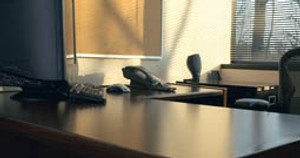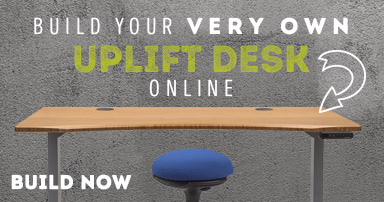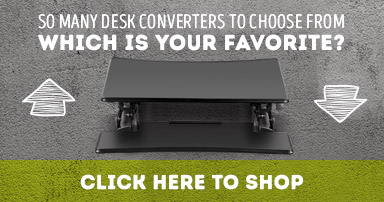Is an L-Shaped Sit-Stand Desk Right for You?
Posted by Human Solution on Oct 16th 2013

When visitors first enter our Austin showroom, it's hard to miss the gorgeous UPLIFT solid wood L-Shaped Sit-Stand Desk located right by the entrance. Adorned with a luxurious 60" x 60" x 30" natural mesquite top with a bark line front edge that was cut, sanded, and finished right here in Austin, it is without a doubt one of the best looking height-adjustable desks we've ever had in our showroom. However, is it the best ergonomic desk we have? The answer may surprise you.
Like many of our items, there simply isn't a one-size-fits-all "best" solution. Knowing what equipment you need to meet your personal needs is one of the key tenets of ergonomics, and the same rule applies to sit-stand desks. While the L-shaped natural wood desks we carry are certainly beautiful and carry a certain executive look to them, there are still pros and cons to be weighed against a traditional rectangular desk. L-shaped desks offer more desktop real estate, but for many users, it simply isn't necessary to have the items that are likely to be placed there travelling up and down with the rest of the desk. For those that do require extra desk space for commonly used items (such as keyboards, mice, notes, media controls, etc.) to remain close at hand, the frequency with which these items are used may make it a better option to use a larger rectangular desk rather in lieu of an L-shaped desk.
The reason? Ergonomists promote keeping frequently used items in the "neutral reach zone" or "optimal reach zone," which Mark Sanders and Ernest McCormick define as "the area that can be conveniently reached with a sweep of the forearm while the upper arm hangs in a natural position at the side" in their book, Human Factors In Engineering and Design. Keeping items in your optimal reach zone helps to reduce the effort associated with accessing commonly used items, thus minimizing stretching motions over your desk for long periods of time that can result in shoulder and back pain. Different desk shapes will result in more or less surface area remaining in the optimal reach zone. The diagram below shows how the optimal reach zone and extended reach zones - the "usable" sections of the desk surface - don't make up as much of the desktop as many people believe it will.

For comparison, here's a similarly-sized 72" x 30" rectangular desk:

Note that while there is in fact a larger optimal reach zone on this L-shaped desk compared to a 72" x 30" rectangular desk, a significant amount of the desk surface in the corner is part of the "outer reach zone." On smaller L-shaped desks such as those that are 60" x 60" x 30", the optimal reach zone becomes even more drastically reduced. Additionally, L-shaped workstations become more cramped when a treadmill is added to the desk, as they simply don't have sufficient room to comfortably accommodate both a chair and a treadmill on the "inside" of the desk corner.
Nonetheless, an L-shaped ergonomic desk will remain the best solution to maintain a large number of static items on the desktop, especially in situations where the work area can only accommodate desks of a certain width, preventing a larger rectangular desk from being installed. For others, a larger, more traditional ergonomic desk such as an UPLIFT Two-Leg Desk with a 72" x 30" or 80" x 30" top may prove more useful and cost efficient. Depending on your space requirements, desk needs, and budget, the "best" desk shape may end up being different from what you envisioned. If you still need help deciding what desk shape is best for you, give us a call at 1-800-531-3746 or chat online with us and one of our ergonomics experts will be happy to help you find the perfect desk.
Learn more about sit-stand desks at TheHumanSolution.com.




